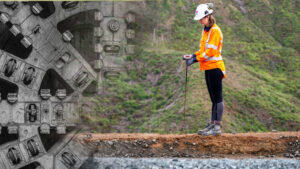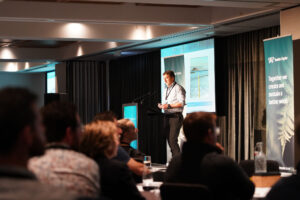As the Local Government New Zealand (LGNZ) SuperLocal conference wraps up, the ‘Brilliant Basics and Beyond’ theme feels especially relevant for 2025.
Ken Macdonald, Water Sector Director at Tonkin + Taylor, shares his thoughts on a new era for local government that demands astute leadership, innovative thinking, and an outcome-driven approach. So, what’s the key to achieving good outcomes in the current industry conditions? Going back to the basics.
Brilliant Basics: Getting Them Right
We’re operating in a dynamic and challenging environment — one where the shape and nature of local government are changing, funding is constrained, and cost pressures are rising, yet the demand for infrastructure services continues to grow.
Communities rightly expect councils to maintain and improve essential services. However, doing more with less is no longer just a catchphrase. It’s the reality we must design and deliver within.
That means becoming smarter about the basics, but doesn’t have to mean neglecting the future needs of our communities or our environment. We also need innovative thinking and fit-for-purpose solutions to do the basics well.
Good Asset Management Is Non-Negotiable
The foundation of getting the basics right is managing our existing infrastructure well. The latest New Zealand Infrastructure Commission report highlights the value of our existing infrastructure. Their recommendation is that 60% of future infrastructure investment should be in renewing and replacing existing infrastructure to maintain service delivery for our communities.
By understanding our existing asset base, and maintaining and optimising assets we already have, we can prolong their useful life. This reduces long-term costs, defers unnecessary replacement, and ensures service continuity.
However, it also requires making wise, needs-based investment decisions. It’s not just about delivering what’s on the books or what meets the design standard; it’s about understanding where the real need lies, challenging standard scopes, and designing fit-for-purpose solutions that can scale or adapt over time.
Across many areas of the country, rates look set to rise — in some cases significantly. At the same time, there is growing pressure to cap the extent of increases. Councils and communities are asking:
How do we continue delivering essential services with minimal frills, while staying within our means?
It comes back to getting the basics right, while also thinking longer-term and more strategically about where we invest today to build resilience for tomorrow.
Invest Upfront to Deliver Better, Smarter Outcomes
Smart investment isn’t just about doing less — it’s about doing things differently. That means:
- Upfront, integrated planning across transport, water, land use, and climate
- Working with consultants and contractors to clarify real needs and scope solutions and deliverables accordingly
- Challenging assumptions about what infrastructure needs to look like
- Using data well to gain insights and understanding of challenges and opportunities with existing and proposed infrastructure.
As an example of some of this in action, Tonkin + Taylor, working in collaboration with local government clients, has jointly developed a Network Capacity Assessment Tool (NCAT). It pulls together existing data to support the identification and mapping of areas where urban growth can best be accommodated within existing water infrastructure.
This, in turn, helps optimise the rates base and support more strategic land development, helping unlock development-ready land, optimise infrastructure investment, and avoid unnecessary upgrades while aligning with broader community and planning goals.
Break the Silos: Plan Once, Deliver Many Times
To do the basics well, we must move beyond siloed thinking. Nature-based solutions (NBS) are a prime example. Too often treated as “green add-ons” to traditional engineering, their potential is vastly under-leveraged when planned in isolation.
A truly holistic approach would see NBS, such as blue-green solutions, designed from the outset as part of a broader infrastructure system. These cost-effective solutions would improve flood resilience while also contributing to urban cooling, biodiversity, transport connectivity, and public well-being.
Cities that have embraced this integrated thinking are seeing the benefits:
- Copenhagen: Parks and urban streetscapes are designed to double as flood management systems during cloudbursts
- Singapore: The Active, Beautiful, Clean (ABC) Waters Programme reimagines water infrastructure as public, green, and beautiful spaces
- Boston: Green infrastructure is layered with equity and climate resilience, targeting underserved communities first
- Closer to home, coordinated efforts in Hamilton and other New Zealand cities show that when councils, planners, and technical experts co-design from the start, multi-benefit infrastructure can be delivered with greater efficiency and impact
Collaboration is Critical
Collaboration within local government and between Councils and the private sector is critical to optimising infrastructure and asset management. Faced with significant investment needs, constrained funding environments, and increasing complexity, no single organisation can afford to operate in isolation.
By working together, Councils can share knowledge, tools, and lessons learned, reducing duplication, accelerating innovation, and lifting the overall capability of the sector. With its technical expertise, delivery experience, and global perspective, the private sector is essential as a partner in co-developing more innovative approaches to planning, funding, and delivering resilient, efficient, and future-ready infrastructure.
A particular opportunity lies in jointly developing and deploying modular, scalable, and replicable solutions — whether in water treatment, digital asset management, or resilience upgrades. Once proven, these can be piloted in one area and rapidly adapted and deployed in others.
Local government can also benefit significantly from insights gained internationally. Countries such as the Netherlands, Singapore, and Denmark are demonstrating integrated, data-driven, and climate-responsive infrastructure approaches that can be tailored to the New Zealand context.
Unlocking the value of this knowledge requires active collaboration, not only within New Zealand but also through structured engagement with global best practice. Let’s bring the best ideas home and adapt them to our unique communities and landscapes.
A Challenge for Local Government
As the infrastructure landscape continues to shift, we need to keep working together as a sector, with and across Councils and Council Controlled Organisations to enable them to:
- Think and plan broadly about the role of infrastructure in shaping resilient, liveable places
- Procure effectively and efficiently, investing in early strategic thinking and cross-disciplinary collaboration
- Manage assets intentionally, combining long-term thinking with short-term pragmatism
Above all, bring the right people together early. When we return to basics and focus on good planning, we can deliver many times over for ratepayers, communities, and future generations.
Let’s not just talk about doing more with less. Let’s work together to plan well and deliver more.
About the Author
An accomplished business leader and consultant, Ken Macdonald heads Tonkin + Taylor’s water sector business, bringing more than 30 years of experience across public and private sector roles in the UK, Europe, Aotearoa New Zealand, and the Pacific Islands.
With specialist expertise in water quality, environmental management, and regulatory compliance, Ken has led large-scale programmes and high-profile organisational development initiatives. He has a strong track record in strategy formulation and execution, business development, and client relationship management, consistently delivering measurable results and driving sustainable impact.






















